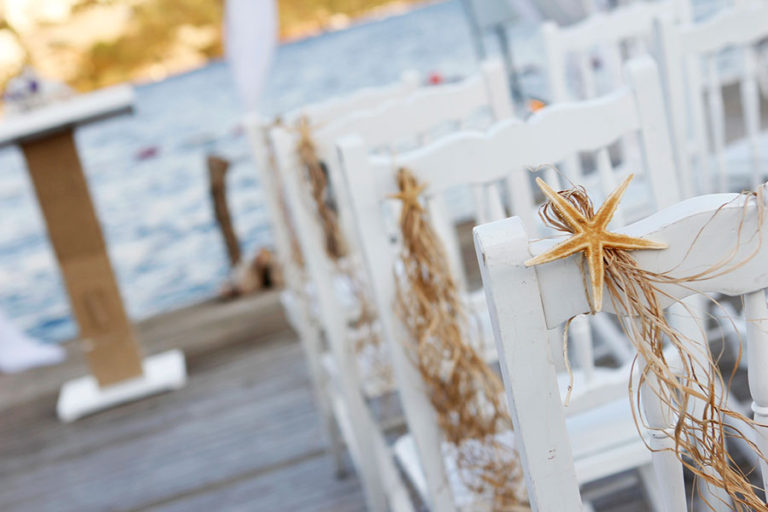
Today’s weddings might still have something blue and something new, but brides are tossing the old and borrowed traditions to embrace their own. As you start to plan your wedding, consider what traditional elements you want to bring to your ceremony, but don’t be afraid to reject the old rules. Here are a few old-school wedding traditions that are getting new makeovers by modern brides.
 The Bride Must Wear White
The Bride Must Wear White
More brides than ever are rejecting the traditional long, white dress. Some women don’t like the symbolism of a “pure virgin bride” presenting herself to her husband, while others simply look better in pink. When Angelina Jolie designed her wedding dress, she looked at what was important in her life and decided to incorporate her kids through their drawings on her train.
For a destination wedding — especially one in the Caribbean — a long, heavy gown might be more trouble than it’s worth. You will have to transport it with all of your other baggage, and might end up sweating though the ceremony. Consider a tea-length dress instead, especially if you’re getting married on the beach
 The Couple Can’t See the Bride Before the Ceremony
The Couple Can’t See the Bride Before the Ceremony
This superstition has nothing to do with luck. Back in the day, marriages were a business transaction between two families, and the bride’s family worried the groom would think she’s ugly and reject the deal if he saw her at all before the ceremony. Today, many couples still follow this tradition to keep the “big reveal” magical.
Instead, create a “first look” photography session before the wedding. This way the moment is captured, and the couple can have a special moment to themselves before the ceremony. Some couples do this and then walk down the aisle together — rejecting the tradition of being “given away” and replacing it with a modern union between two individuals.
 The Bride’s Family Must Pay for the Ceremony
The Bride’s Family Must Pay for the Ceremony
Historically, the bride’s family paid for the ceremony while the groom’s family paid for the honeymoon. Today, most weddings are paid for by a combination of the parents and couple. Typically, both sets of in-laws meet to discuss the size and type of wedding and work to decide who will pay for what. One rule of thumb stands: whoever is paying for the wedding has a saying the planning of it.
Many couples are opting for destination wedding packages. This way they’re able to combine the ceremony and the honeymoon, while limiting the number of guests. This also keeps nosey family members from offering their opinions on the flowers, location, and food until they’re actually there.
 The Guests are Divided on Different Sides
The Guests are Divided on Different Sides
You don’t have to treat your wedding like a football game, with half of your friends and family cheering for one partner. If weddings are supposed to merge two families, then why do we still keep them apart during the ceremony? Let your guests sit wherever they want, regardless of who they’re related to. The best time to get to know your new family is the present.
 Your Registry is Meant to Furnish Your Home
Your Registry is Meant to Furnish Your Home
More couples than ever live together before getting married, which makes creating a wedding registry challenging. After all, if your registry is meant to furnish your new home, are you supposed to replace all of your current household items? This is why many registries have more waffle makers than flatware — why ask for something that you already have?
Instead, couples are creating “honeymoon registries” where friends and family can donate to their travels or for the wedding itself. There are also “home buying registries” for a down payment on a house. The Internet has also modernized this tradition, and couples can create a universal registry online and select items from 20 different stores instead of one.
These are just a few examples that you’ll encounter during your wedding planning. Whenever an established tradition pops up, ask yourself, “Will this make us happy, or are we just following old rules?” If your answer is the latter, then it’s okay to ignore it. Make your wedding, your own!

